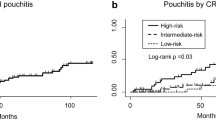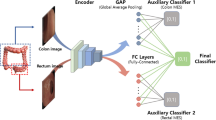Abstract
Background
Pouchitis is one of the major postoperative complications of ulcerative colitis (UC), and it is still difficult to predict the development of pouchitis after ileal pouch–anal anastomosis (IPAA) in UC patients. In this study, we examined whether a deep learning (DL) model could predict the development of pouchitis.
Methods
UC patients who underwent two-stage restorative proctocolectomy with IPAA at Keio University Hospital were included in this retrospective analysis. The modified pouchitis disease activity index (mPDAI) was evaluated by the clinical and endoscopic findings. Pouchitis was defined as an mPDAI ≥ 5.860; endoscopic pouch images before ileostomy closure were collected. A convolutional neural network was used as the DL model, and the prediction rates of pouchitis after ileostomy closure were evaluated by fivefold cross-validation.
Results
A total of 43 patients were included (24 males and 19 females, mean age 39.2 ± 13.2 years). Pouchitis occurred in 14 (33%) patients after ileostomy closure. In less than half of the patients, mPDAI scores matched before and after ileostomy closure. Most of patients whose mPDAI scores did not match before and after ileostomy closure had worse mPDAI scores after than before. The prediction rate of pouchitis calculated by the area under the curve using the DL model was 84%. Conversely, the prediction rate of pouchitis using mPDAI before ileostomy closure was 62%.
Conclusion
The prediction rate of pouchitis using the DL model was more than 20% higher than that using mPDAI, suggesting the utility of the DL model as a prediction model for the development of pouchitis. It could also be used to determine early interventions for pouchitis.




Similar content being viewed by others
Availability of data and material
Due to the sensitive nature of the questions asked in this study, survey respondents were assured raw data would remain confidential and would not be shared.
Code availability
Not applicable.
References
Ordás I, Eckmann L, Talamini M, Baumgart DC, Sandborn WJ (2012) Ulcerative colitis. Lancet 380:1606–1619
Ng KS, Gonsalves SJ, Sagar PM (2019) Ileal-anal pouchitis: a review of history, indications, and complications. World J Gastroenterol 25:4320–4342
Dalal RL, Shen B, Schwartz DA (2018) Management of pouchitis and other common complications of the pouch. Inflamm Bowel Dis 24:989–996
Peyrin-Biroulet L, Germain A, Patel AS, Lindsay JO (2016) Systematic review: outcomes and post-operative complications following colectomy for ulcerative colitis. Aliment Pharmacol Ther 44:807–816
Madiba TE, Bartolo DC (2001) Pouchitis following restorative proctocolectomy for ulcerative colitis: incidence and therapeutic outcome. J R Coll Surg Edinb 46:334–337
Bo S (2012) Acute and chronic pouchitis—pathogenesis, diagnosis, and treatment. Nat Rev Gastroenterol Hepatol 9:323–333
Hata K, Ishihara S, Nozawa H et al (2017) pouchitis after ileal pouch-anal anastomosis in ulcerative colitis: diagnosis, management, risk factors, and incidence. Dig Endosc 29:26–34
Ruffle JK, Farmer AD, Aziz Q (2019) Artificial intelligence-assisted gastroenterology—promise and pitfalls. Am J Gastroenterol 114:422–428
Lakhani P, Gray DL, Pett CR, Nagy P, Shih G (2018) Hello world deep learning in medical imaging. J Digit Imaging 31:283–289
Wainberg M, Merico D, Delong A, Frey BJ (2018) Deep learning in biomedicine. Nat Biotechnol 36:829–838
González G, Ash SY, Vegas-Sánchez-Ferrero G et al (2018) Disease staging and prognosis in smokers using deep learning in chest computed tomography. Am J Respir Crit Care Med 197:193–203
Nguyen BP, Pham HN, Tran H et al (2019) Predicting the onset of type 2 diabetes using wide and deep learning with electronic health records. Comput Methods Programs Biomed 182:105055
Cai SL, Li B, Tan WM et al (2019) Using a deep learning system in endoscopy for screening of early esophageal squamous cell carcinoma (with video). Gastrointest Endosc 90:745–753
Ito N, Kawahira H, Nakashima H, Uesato M, Miyauchi H, Matsubara H (2018) Endoscopic diagnostic support system for cT1b colorectal cancer using deep learning. Oncology 96:44–50
Sandborn WJ (1994) Pouchitis following ileal pouch-anal anastomosis: definition, pathogenesis, and treatment. Gastroenterology 107:1856–1860
Itoh T, Kawahira H, Nakashima H, Yata N (2018) Deep learning analyzes Helicobacter pylori infection by upper gastrointestinal endoscopy images. Endosc Int Open 6:E139–E144
Yasaka K, Akai H, Kunimatsu A, Kiryu S, Abe O (2018) Deep learning with convolutional neural network in radiology. Jpn J Radiol 36:257–272
Sengul N, Wexner SD, Hui SM et al (2006) Anatomic extent of colitis and disease severity are not predictors of pouchitis after restorative proctocolectomy for mucosal ulcerative colitis. Tech Coloproctol 10:29–34
Araki T, Hashimoto K, Okita Y et al (2018) Colonic histological criteria predict development of pouchitis after ileal pouchi: Anal anastomosis for patients with ulcerative colitis. Dig Surg 35:138–143
Murrell Z, Vasiliauskas E, Melmed G, Lo S, Targen S, Fleshner P (2010) Preoperative wireless capsule endoscopy does not predict outcome after ileal pouch-anal anastomosis. Dis Colon Rectum 53:293–300
Yamamoto T, Shimoyama T, Bamba T, Matsumoto K (2015) Consecutive monitoring of fecal calprotectin and lactoferrin for the early diagnosis and prediction of pouchitis after restorative proctocolectomy for ulcerative colitis. Am J Gastroenterol 110:881–887
Zhao YY, Xue DX, Wang YL et al (2018) Computer-assisted diagnosis of early esophageal squamous cell carcinoma using narrow-band imaging magnifying endoscopy. Endoscopy 51:333–341
Komeda Y, Handa H, Watanabe T et al (2017) Computer-aided diagnosis based on convolutional neural network system for colorectal polyp classification: preliminary experience. Oncology 93:30–34
Korbar B, Olofson AM, Miraflor AP et al (2017) Deep learning for classification of colorectal polyps on whole-slide images. J Pathol Inform 8:30
Lee JH, Kim YJ, Kim YW et al (2019) Spotting malignancies from gastric endoscopic images using deep learning. Surg Endosc 33:3790–3797
An P, Yang D, Wang J et al (2020) A deep learning method for delineating early gastric cancer resection margin under chromoendoscopy and white light endoscopy. Gastric Cancer 23:884–892
Min JK, Kwak MS, Cha JM (2019) Overview of deep learning in gastrointestinal endoscopy. Gut Liver 13:388–393
Acknowledgements
The English in this document has been checked by a professional editor who is a native speaker of English.
Funding
The authors state no grant support or financial relationships.
Author information
Authors and Affiliations
Contributions
SM: conceptualization, methodology, writing-original draft. KO: conceptualization, methodology, data curation, supervision, writing, review and editing. AI: data curation, supervision. SM: data curation, supervision. RS: data curation, supervision. KS: data curation, supervision. YK: project administration. All authors read and approved the final manuscript.
Corresponding author
Ethics declarations
Conflict of interest
The authors declare that they have no conflict of interest.
Ethics approval
The study was approved by Keio University’s Ethics Committee (20150051).
Informed consent
All patients signed the institution informed consent for colorectal surgery. No specific consent for this type of study is required.
Consent for publication
Consent to submit the present paper has been received explicitly from all co-authors, as well as from Keio University’s Ethics Committee.
Additional information
Publisher's Note
Springer Nature remains neutral with regard to jurisdictional claims in published maps and institutional affiliations.
Rights and permissions
About this article
Cite this article
Mizuno, S., Okabayashi, K., Ikebata, A. et al. Prediction of pouchitis after ileal pouch–anal anastomosis in patients with ulcerative colitis using artificial intelligence and deep learning. Tech Coloproctol 26, 471–478 (2022). https://doi.org/10.1007/s10151-022-02602-3
Received:
Accepted:
Published:
Issue Date:
DOI: https://doi.org/10.1007/s10151-022-02602-3




